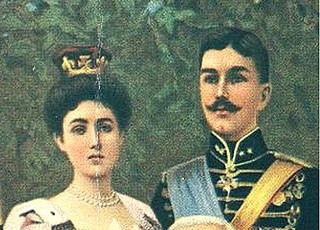Styles represent the fashion by which monarchs and noblemen are properly addressed. Throughout history, many different styles were used, with little standardization. This page will detail the various styles used by royalty and nobility in Europe, in the final form arrived at in the nineteenth century.
Morganatic marriage, sometimes called a left-handed marriage, is a marriage between people of unequal social rank, which in the context of royalty prevents the husband's titles and privileges being passed on to the wife and/or any children born of the marriage.
A prince is a male ruler or member of a monarch's or former monarch's family. Prince is also a title of nobility, often hereditary, in some European states. The feminine equivalent is a princess. The English word derives, via the French word prince, from the Latin noun princeps, from primus (first) and capio, meaning "the first, foremost, the chief, most distinguished, noble ruler, prince".
A duke (male) can either be a monarch ranked below the emperor, king, and grand duke ruling over a duchy or a member of royalty or nobility, historically of highest rank, below princes of nobility and grand dukes. The title comes from French duc, itself from the Latin dux, 'leader', a term used in republican Rome to refer to a military commander without an official rank, and later coming to mean the leading military commander of a province. In most countries, the word duchess is the female equivalent. However, in some countries, the term duke is used even for females, and the word duchess is reserved for those who marry dukes.

A duchy is a medieval country, territory, fief, or domain ruled by a duke or duchess, a high-ranking nobleman hierarchically second to the king or queen in European tradition. The term is used almost exclusively in Europe, where in the present day there is no sovereign duchy left.
Grand Duke is a European hereditary title for either certain monarchs or members of certain monarchs' families. It is traditionally ranked in order of precedence below the title of emperor, king or archduke and above that of sovereign prince or sovereign duke. It is used in some current and former independent monarchies in Europe, particularly:
A grand duchy is a country or territory whose official head of state or ruler is a monarch bearing the title of grand duke or grand duchess.
The Grand Ducal Family of Luxembourg constitutes the House of Luxembourg-Nassau, headed by the sovereign Grand Duke, and in which the throne of the grand duchy is hereditary. It consists of heirs and descendants of the House of Nassau-Weilburg, whose sovereign territories passed cognatically from the House of Nassau to a cadet branch of the House of Bourbon-Parma, itself a branch of the Spanish Royal House which is agnatically a cadet branch of the House of Capet that originated in France. This is descended from the Capetian dynasty – itself a derivative dynasty from the Robertians.

William IV reigned as the Grand Duke of Luxembourg from 17 November 1905 until his death. He succeeded his father, Adolphe.

Marie-Adélaïde, reigned as Grand Duchess of Luxembourg from 1912 until her abdication in 1919. She was the first Grand Duchess regnant of Luxembourg, its first female monarch since Duchess Maria Theresa and the first Luxembourgish monarch to be born within the territory since Count John the Blind (1296–1346).
Royal Highness is a style used to address or refer to some members of royal families, usually princes or princesses. Monarchs and their consorts are usually styled Majesty. When used as a direct form of address, spoken or written, it takes the form "Your Royal Highness". When used as a third-person reference, it is gender-specific and, in plural, Their Royal Highnesses (TRH).

Prince Félix of Bourbon-Parma, later Prince Félix of Luxembourg, was the husband of Charlotte, Grand Duchess of Luxembourg and the father of her six children, including her successor: Grand Duke Jean. He was the longest serving consort of Luxembourg.
His/Her Serene Highness is a style used today by the reigning families of Liechtenstein, Monaco, and Thailand. Until 1918, it was also associated with the princely titles of members of some German ruling and mediatised dynasties and with a few princely but non-ruling families. It was also the form of address used for cadet members of the dynasties of France, Italy, Russia and Ernestine Saxony, under their monarchies. Additionally, the treatment was granted for some, but not all, princely yet non-reigning families of Bohemia, Hungary, Italy, Poland, Romania and Russia by emperors or popes. In a handful of rare cases, it was employed by non-royal rulers in viceregal or even republican contexts.

The House of Mecklenburg, also known as Nikloting, is a North German dynasty that ruled until 1918 in the Mecklenburg region, being among the longest-ruling families of Europe. Queen Juliana of the Netherlands (1909-2004), former Queen of the Netherlands (1948-1980), was an agnatic member of this house.
Highness is a formal style used to address or refer to certain members of a reigning or formerly reigning dynasty. It is typically used with a possessive adjective: "His Highness", "Her Highness" (HH), "Their Highnesses", etc. Although often combined with other adjectives of honour indicating rank, such as "Imperial", "Royal" or "Serene", it may be used alone.
The German nobility and royalty were status groups of the medieval society in Central Europe, which enjoyed certain privileges relative to other people under the laws and customs in the German-speaking area, until the beginning of the 20th century.
Prince étranger was a high, though somewhat ambiguous, rank at the French royal court of the Ancien Régime.
The Pauline Laws are the house laws of the House of Romanov of the Russian Empire. The name comes from the fact that they were initially established by Emperor Paul I of Russia in 1797.